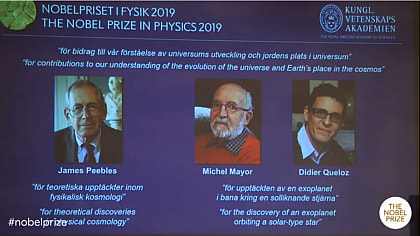
スウェーデンの王立科学アカデミーは8日、2019年のノーベル物理学賞を、宇宙理論や太陽系外惑星発見を通じ、壮大な宇宙についての人類の理解を大きく前進させた、米国、スイス、英国の大学の3氏の研究者に授与する、と発表した。
3氏は米国・プリンストン大学のジェームズ・ピーブルズ氏、スイス・ジュネーブ大学のミシェル・マイヨール氏、ジュネーブ大学と英国・ケンブリッジ大学のディディエ・ケロー氏。
授賞式は12月10日にストックホルムで開かれる。賞金900万スウェーデン・クローナ(約9700万円)の半分はピーブルズ氏に、残り半分がマイヨール氏とケロー氏に贈られる。
ピーブルズ氏は、宇宙の背景放射と呼ばれる天体現象などの理論研究を通じ、宇宙がその始まりである「ビッグバン」の直後から膨張を続け、現在の姿になるまでの進化を理論的に解明した。
マイヨール氏とケロー氏は、南フランスの観測施設を使って、1995年に地球から約50光年離れたペガスス座の方向の宇宙に太陽系外惑星が存在することを初めて確認した。この惑星は木星のようなガスでできた惑星だった。
ケロー氏らの画期的な宇宙観測の前は、惑星は太陽系にしかないと考えられていた。同氏らの業績の後、現在までに4000以上の太陽系外惑星が確認されている。この中には地球に似た惑星も含まれ、生命存在への期待も高まっている。
The Nobel Prize in Physics 2019
https://www.nobelprize.org/prizes/physics/2019/summary/
Announcement of the Nobel Prize in Physics 2019
今年は「宇宙」の分野で受賞が決まった。発表では次のようなスライドが映されている。

コーヒー(ダーク・エネルギー)にクリーム(ダーク・マター)と砂糖(物質)を入れて宇宙の構成を説明

宇宙背景放射(解説記事)

初めて観測された系外惑星の位置(ペガスス座51番星b)

太陽型恒星のドップラー効果により系外惑星の存在が確認された

発表のタイミングで公開されたプレスリリースを和訳したものを載せておこう。
プレスリリース(英語):
https://www.nobelprize.org/uploads/2019/10/press-physics2019.pdf
日本語訳:
2019年ノーベル物理学賞
“物理宇宙論についてのいくつかの理論的発見に対して”
ジェームズ・ピーブルズ
米国・プリンストン大学
“太陽型恒星を周回する系外惑星の発見に対して”
ミシェル・マイヨール
スイス・ジュネーブ大学
ディディエ・ケロー
ジュネーブ大学と英国・ケンブリッジ大学
宇宙における我々の新しい眺望に対しての授賞
今年のノーベル物理学賞は宇宙の構造と歴史に対して新しい理解をもたらしたこと、そして太陽系外の太陽型の恒星の周りを公転する惑星の最初の発見に対して授賞する。
ジェームズ・ピーブルズ博士の物理宇宙論についての洞察は、科学への思索的見地から過去50年にわたる宇宙論の変遷の基礎に広がるあらゆる領域の研究を豊かなものにした。1960年代半ばから開発された博士の理論的な枠組みは、私たちの宇宙に対する現在の理解の基礎となっている。
140億年近く前の宇宙のまさに最初の瞬間を説明するビッグ・バン・モデルは、その瞬間が極めて熱く濃密であったことを示している。その時以来、宇宙は膨張し続け、より広く冷たくなっている。ビッグ・バンからおよそ40万年後、宇宙は透明になり、光線は宇宙のあらゆる場所に行き渡ることになった。現在もなお、この太古の放射は私たちの周囲にあり、その中には宇宙の多くの謎が暗号のように隠されている。博士の理論的なツールと計算によって宇宙の子供時代の痕跡が解釈できるようになり、いくつもの新しい物理プロセスが発見できるようになった。
その結果、恒星、惑星や木、そして私たち自身など見えているすべてのものは、宇宙を構成するもののうちたった5パーセントにすぎないことがわかった。そして残りの95パーセントは未知のダーク・マターとダーク・エネルギーである。これは神秘であり、現代物理学の挑戦となる。
1995年10月、ミシェル・マイヨール博士とディディエ・ケロー博士は、私たちの太陽系の外にある惑星を初めて発見したことを発表した。それは私たちが属している銀河系、天の川にある太陽型の恒星を公転する惑星で、南フランスのオート=プロヴァンス天文台で特注した複数の機材を使って発見された。これらの機材により太陽系で最大の気体惑星である木星に比類するペガスス座51番星b(という太陽系外惑星)を見ることができた。
この発見は天文学における革命の始まりであり、その後銀河系内で4000個を超える系外惑星が発見された。不思議な新しい世界の発見はそれ以来続いており、信じがたいさまざまなサイズ、形、軌道のものが見つかっている。これらの系外惑星は惑星系についての先入観への挑戦となり、科学者たちは惑星の起源に潜む物理プロセスの理論を書き換えることが必要になった。系外惑星を探索する数々のプロジェクトが計画され、もしかすると私たちはこれまで抱き続けてきた(系外惑星に)地球外生命の存在するのか?という問いへの答えを、突然得ることになるかもしれない。
今年の受賞者たちは、宇宙についての私たちの認識を変えた。ジェームズ・ピーブルズ博士の理論的な数々の発見は、ビッグ・バン以後の宇宙の進化についての私たちの理解に貢献し、ミシェル・マイヨール博士とディディエ・ケロー博士は、未知の惑星を捜索することで私たちの宇宙の隣人の探査に貢献した。彼らの発見はこれまで私たちが抱いていた世界の概念を永遠に変えることになった。
ピーブルズ博士、マイヨール博士、ケロー博士、物理学賞受賞おめでとうございます。
関連書籍:
宇宙に「終わり」はあるのか: 吉田伸夫(ピーブルズ博士の業績が書かれている)
https://blog.goo.ne.jp/ktonegaw/e/c9ad8a76d2a1725b731238eeb4699694
宇宙が始まる前には何があったのか?: ローレンス・クラウス
https://blog.goo.ne.jp/ktonegaw/e/b6f36e8eedba5ee63a4f919d30a2cb20
宇宙創世はじめの3分間 (ちくま学芸文庫):S. ワインバーグ
https://blog.goo.ne.jp/ktonegaw/e/cd00222f81ac344af10061b48e4d289d
ワインバーグの宇宙論(上)ビッグバン宇宙の進化
https://blog.goo.ne.jp/ktonegaw/e/bd3d49fe1e13bcdd97116b33e8c736bb
ワインバーグの宇宙論(下): ゆらぎの形成と進化
https://blog.goo.ne.jp/ktonegaw/e/13c2b81456935c281b4c57a014cd9d60
系外惑星の本: 書籍版を検索 Kindle版を検索
ノーベル物理学賞の注目度
ノーベル物理学賞が世間でどれだけの関心を引いているのか、Google Trendsで調べてみた。一時的なことであるが、「消費税」への関心を超えていた。(「年金」への関心には少しおよばなかった。)

Google Trends: 現時点で調べてみる
メルマガを書いています。(目次一覧)

応援クリックをお願いします。




英語原文:
The Nobel Prize in Physics 2019
“for theoretical discoveries in physical cosmology”
James Peebles, born 1935 in Winnipeg, Canada. Ph.D. 1962 from Princeton University, USA. Albert Einstein Professor of Science at Princeton University, USA.
“for the discovery of an exoplanet orbiting a solar-type star”
Michel Mayor, born 1942 in Lausanne, Switzerland. Ph.D. 1971 from University of Geneva, Switzerland. Professor at University of Geneva, Switzerland.
Didier Queloz, born 1966. Ph.D. 1995 from University of Geneva, Switzerland. Professor at University of Geneva, Switzerland and University of Cambridge, UK.
New perspectives on our place in the universe
This year's Nobel Prize in Physics rewards new understanding of the universe's structure and history, and the first discovery of a planet orbiting a solar-type star outside our solar system.
James Peebles' insights into physical cosmology have enriched the entire field of research and laid a foundation for the transformation of cosmology over the last fifty years, from speculation to science. His theoretical framework, developed since the mid-1960s, is the basis of our contemporary ideas about the universe.
The Big Bang model describes the universe from its very first moments, almost 14 billion years ago, when it was extremely hot and dense. Since then, the universe has been expanding, becoming larger and colder. Barely 400,000 years after the Big Bang, the universe became transparent and light rays were able to travel through space. Even today, this ancient radiation is all around us and, coded into it, many of the universe's secrets are hiding. Using his theoretical tools and calculations, James Peebles was able to interpret these traces from the infancy of the universe and discover new physical processes.
The results showed us a universe in which just five per cent of its content is known, the matter which constitutes stars, planets, trees – and us. The rest, 95 per cent, is unknown dark matter and dark energy. This is a mystery and a challenge to modern physics.
In October 1995, Michel Mayor and Didier Queloz announced the first discovery of a planet outside our solar system, an exoplanet, orbiting a solar-type star in our home galaxy, the Milky Way. At the Haute-Provence Observatory in southern France, using custom-made instruments, they were able to see planet 51 Pegasi b, a gaseous ball comparable with the solar system's biggest gas giant, Jupiter.
This discovery started a revolution in astronomy and over 4,000 exoplanets have since been found in the Milky Way. Strange new worlds are still being discovered, with an incredible wealth of sizes, forms and orbits. They challenge our preconceived ideas about planetary systems and are forcing scientists to revise their theories of the physical processes behind the origins of planets. With numerous projects planned to start searching for exoplanets, we may eventually find an answer to the eternal question of whether other life is out there.
This year's Laureates have transformed our ideas about the cosmos. While James Peebles' theoretical discoveries contributed to our understanding of how the universe evolved after the Big Bang, Michel Mayor and Didier Queloz explored our cosmic neighbourhoods on the hunt for unknown planets. Their discoveries have forever changed our conceptions of the world.






















